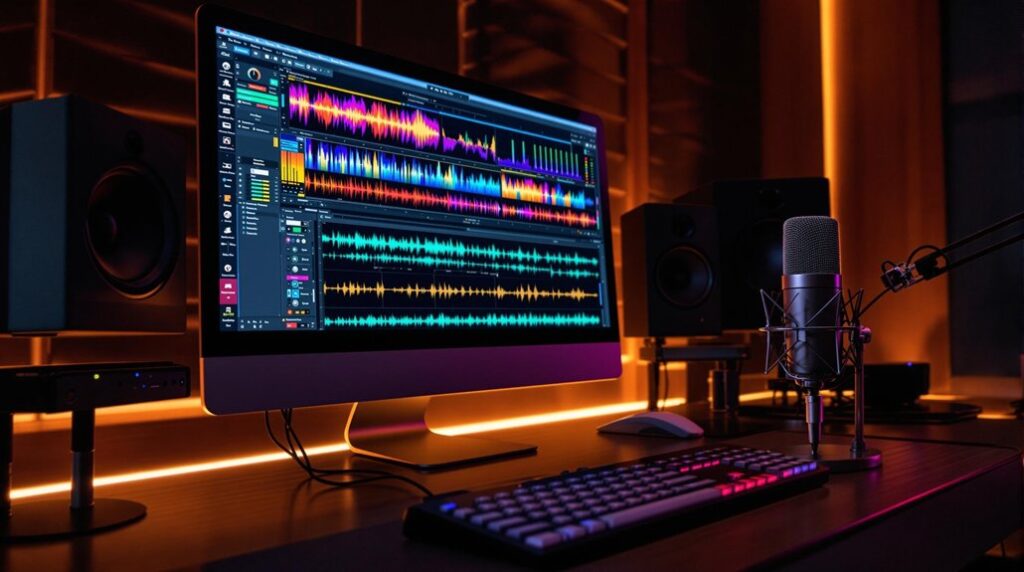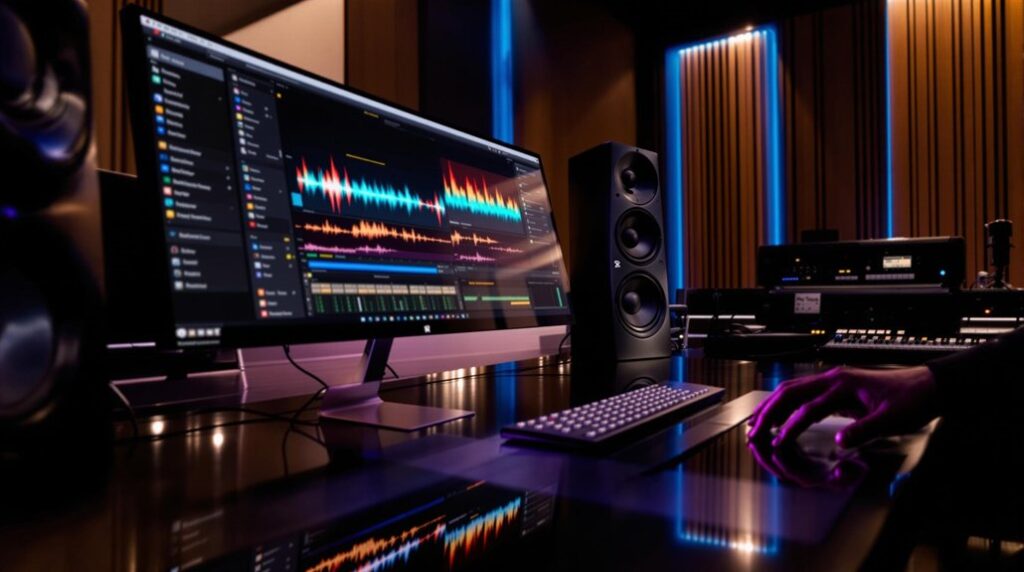To create a Pro Tools mixing template for seamless workflow, begin by setting up a session with clear track organization, using mono audio tracks and auxiliary tracks for efficient routing. Implement color coding for visual clarity and set up dedicated buses for dialogue, music, and effects. Apply a structured signal processing chain, starting with dynamics control and followed by detailed EQ adjustments. Save plugin settings for quick access and guarantee your template aligns with your workflow preferences. Incorporate collaboration tools to enhance productivity. By refining each step, you'll optimize the template for effective audio processing and seamless project management.
Key Takeaways
- Initiate a new session and set up I/O settings to manage signal flow effectively.
- Organize tracks with dedicated buses for dialogue, music, effects, and reverb.
- Implement color coding and auxiliary tracks for visual and routing efficiency.
- Create and save plugin settings, effects chains, and templates for quick access.
- Use collaboration tools like Evercast for remote teamwork and project management.
Setting Up Your Session
Initiate your Pro Tools journey by establishing a new session, which serves as the foundation of your mixing template. Begin by naming it appropriately, such as "YourName_MixingTemplate_V1," to maintain a structured setup. Configure the input/output (I/O) settings to define signal flow, essential for seamless audio management. Create mono audio tracks specifically for dialogue using the shortcuts Shift + Command + N, and label them clearly, such as "DX." Implement color coding, like blue for dialogue, to enhance visual organization. Establish auxiliary tracks for processing, such as a dialogue chain, and guarantee signals are routed from dialogue tracks to corresponding buses. Finally, setup stereo buses for effects like reverb by routing inputs from dialogue tracks to maintain mixing clarity and efficiency. To ensure your session is consistently organized, utilize the session template feature, which aids in maintaining track layouts and mixer configurations.
Organizing Tracks and Buses
With the basic session setup complete, attention now turns to organizing tracks and buses to optimize workflow efficiency. In audio engineering, creating a cohesive structure involves establishing dedicated buses for dialogue, music, effects, and reverb. This approach guarantees order and consistency across projects. Use shortcuts, such as Shift + Command + N, to create mono audio tracks for dialogue, labeling them clearly (e.g., DX). Color coding, such as blue for dialogue, enhances visual organization, while auxiliary (Ox) tracks facilitate routing. Assign dialogue tracks to the dialogue chain, highlighted in green for clarity. Monitor signal routing meticulously to streamline processing. Using Pro Tools playlists allows for non-destructive editing and efficient take management, which further enhances the organization and workflow.
| Element | Action |
|---|---|
| Dialogue Buses | Establish and route tracks |
| Track Naming | Use clear identifiers (DX) |
| Color Coding | Blue for dialogue tracks |
| Ox Tracks | Green for dialogue chain |
Signal Processing Essentials
Signal processing forms the backbone of any well-structured mixing session in Pro Tools.
In audio production, establishing a robust dialogue chain starts with a mono path named "DX chain" to manage signal flow efficiently. Route dialogue tracks here for initial processing.
To introduce spatial depth, implement a stereo bus, "DX verb", where dialogue tracks send their audio for reverb effects.
Utilize a 7-band EQ, like FabFilter Pro-Q, across dialogue channels for swift frequency adjustments using shift-option automation.
Prioritize a compressor or limiter at the beginning of the chain to control dynamics, accompanied by a de-esser to mitigate sibilance.
Understanding Pro Tools signal flow is crucial for achieving optimal sound quality, as it influences the routing and processing of audio signals.
Guarantee a pristine signal pre-effects, finalizing with EQ adjustments post-dynamics for peak clarity and cohesion.
Customizing and Updating Templates
Although the foundation of your Pro Tools mixing template is crucial, regular customization and updates are essential to keep it effective and relevant in a dynamic audio engineering environment.
Customize your template by saving preferred plugin settings and effects chains, streamlining access during sessions. Tailor the layout to align with personal workflow preferences, utilizing color coding and organized track arrangements by instrument or function to enhance visual clarity.
Regular updates should incorporate feedback from diverse projects, guaranteeing continued relevance and adaptability. Experimentation with audio elements within the template supports creative flexibility while maintaining a consistent framework.
Documenting the features of your customized template facilitates easy navigation, optimizing workflow efficiency for future projects. This methodical approach guarantees your template evolves alongside your needs. Additionally, integrating custom keyboard shortcuts can significantly enhance workflow efficiency by minimizing time spent on manual navigation and allowing for quicker task management.
Collaboration and Remote Tools
Maneuvering the complexities of modern audio production necessitates robust collaboration and remote tools. Evercast enhances Pro Tools sessions by offering HD streaming capabilities, integrated video chat, and note exchange features, ensuring seamless teamwork.
These features complement mixing templates by allowing real-time collaboration, enhancing workflow efficiency. Secure streaming up to 4K guarantees high-quality communication, essential for remote production.
Effective project management tools organize tasks and deadlines, keeping team members aligned during the mixing process. Regular check-ins are critical, fostering productivity and creativity.
Utilizing tools like Evercast not only reduces production timelines but also allows for the incorporation of diverse perspectives. This integration leads to improved project outcomes, showcasing the importance of collaboration in refining mixing templates. With Pro Tools, automatic delay compensation ensures precise timing by adjusting for latency issues, further enhancing the accuracy and quality of collaborative projects.
Frequently Asked Questions
How to Create a Template in Pro Tools?
Creating a template in Pro Tools entails establishing a consistent session layout by pre-configuring tracks, effects, and routing. Template benefits include enhanced efficiency, streamlined workflow, and adaptability, ensuring consistency across projects and facilitating quicker setup times.
How to Make a Good Mixing Template?
To make a good mixing template, focus on Template Essentials such as organized track layout, labeled and color-coded elements, efficient bus routing, pre-loaded effects and plugins, and regular updates. Testing guarantees adaptability and enhances workflow efficiency.
How Do I Create a Mix Bus in Pro Tools?
To create a Mix Bus in Pro Tools, initiate an auxiliary track via the "Track" menu. Assign its input to a designated bus, then route individual track outputs to this bus, enabling collective processing and streamlined audio management.
How Do I Create a Mix Group in Pro Tools?
To create a mix group in Pro Tools, select desired tracks, then apply the shortcut Command + Shift + G (Mac) or Control + Shift + G (Windows). Utilize Mixing Techniques to adjust parameters for cohesive control across grouped audio elements.
Conclusion
In summary, constructing an efficient Pro Tools mixing template necessitates meticulous session setup, strategic track and bus organization, and thoughtful application of signal processing. Regular customization and updates guarantee adaptability to evolving project requirements. The integration of collaboration and remote tools further enhances workflow efficiency. By adhering to these structured processes, audio professionals can achieve streamlined operations, reducing time spent on repetitive tasks and allowing greater focus on creative and technical aspects of mixing.




